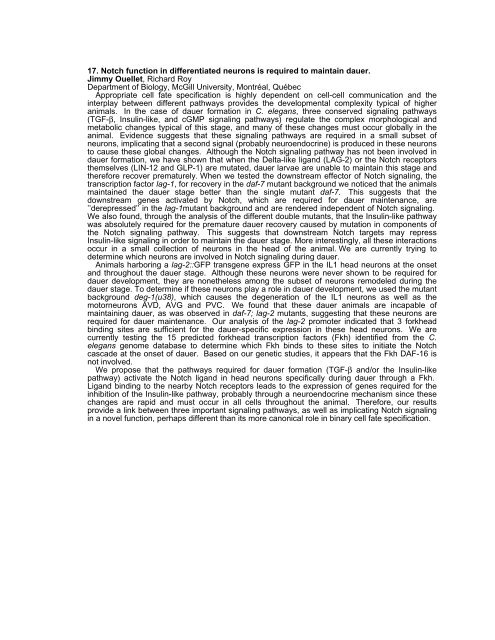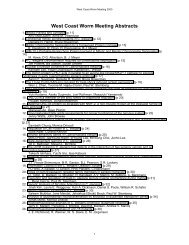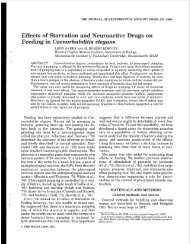Program of the 2004 East Coast Worm Meeting - Caenorhabditis ...
Program of the 2004 East Coast Worm Meeting - Caenorhabditis ...
Program of the 2004 East Coast Worm Meeting - Caenorhabditis ...
Create successful ePaper yourself
Turn your PDF publications into a flip-book with our unique Google optimized e-Paper software.
17. Notch function in differentiated neurons is required to maintain dauer.<br />
Jimmy Ouellet, Richard Roy<br />
Department <strong>of</strong> Biology, McGill University, Montréal, Québec<br />
Appropriate cell fate specification is highly dependent on cell-cell communication and <strong>the</strong><br />
interplay between different pathways provides <strong>the</strong> developmental complexity typical <strong>of</strong> higher<br />
animals. In <strong>the</strong> case <strong>of</strong> dauer formation in C. elegans, three conserved signaling pathways<br />
(TGF-β, Insulin-like, and cGMP signaling pathways) regulate <strong>the</strong> complex morphological and<br />
metabolic changes typical <strong>of</strong> this stage, and many <strong>of</strong> <strong>the</strong>se changes must occur globally in <strong>the</strong><br />
animal. Evidence suggests that <strong>the</strong>se signaling pathways are required in a small subset <strong>of</strong><br />
neurons, implicating that a second signal (probably neuroendocrine) is produced in <strong>the</strong>se neurons<br />
to cause <strong>the</strong>se global changes. Although <strong>the</strong> Notch signaling pathway has not been involved in<br />
dauer formation, we have shown that when <strong>the</strong> Delta-like ligand (LAG-2) or <strong>the</strong> Notch receptors<br />
<strong>the</strong>mselves (LIN-12 and GLP-1) are mutated, dauer larvae are unable to maintain this stage and<br />
<strong>the</strong>refore recover prematurely. When we tested <strong>the</strong> downstream effector <strong>of</strong> Notch signaling, <strong>the</strong><br />
transcription factor lag-1, for recovery in <strong>the</strong> daf-7 mutant background we noticed that <strong>the</strong> animals<br />
maintained <strong>the</strong> dauer stage better than <strong>the</strong> single mutant daf-7. This suggests that <strong>the</strong><br />
downstream genes activated by Notch, which are required for dauer maintenance, are<br />
’’derepressed’’ in <strong>the</strong> lag-1mutant background and are rendered independent <strong>of</strong> Notch signaling.<br />
We also found, through <strong>the</strong> analysis <strong>of</strong> <strong>the</strong> different double mutants, that <strong>the</strong> Insulin-like pathway<br />
was absolutely required for <strong>the</strong> premature dauer recovery caused by mutation in components <strong>of</strong><br />
<strong>the</strong> Notch signaling pathway. This suggests that downstream Notch targets may repress<br />
Insulin-like signaling in order to maintain <strong>the</strong> dauer stage. More interestingly, all <strong>the</strong>se interactions<br />
occur in a small collection <strong>of</strong> neurons in <strong>the</strong> head <strong>of</strong> <strong>the</strong> animal. We are currently trying to<br />
determine which neurons are involved in Notch signaling during dauer.<br />
Animals harboring a lag-2::GFP transgene express GFP in <strong>the</strong> IL1 head neurons at <strong>the</strong> onset<br />
and throughout <strong>the</strong> dauer stage. Although <strong>the</strong>se neurons were never shown to be required for<br />
dauer development, <strong>the</strong>y are none<strong>the</strong>less among <strong>the</strong> subset <strong>of</strong> neurons remodeled during <strong>the</strong><br />
dauer stage. To determine if <strong>the</strong>se neurons play a role in dauer development, we used <strong>the</strong> mutant<br />
background deg-1(u38), which causes <strong>the</strong> degeneration <strong>of</strong> <strong>the</strong> IL1 neurons as well as <strong>the</strong><br />
motorneurons AVD, AVG and PVC. We found that <strong>the</strong>se dauer animals are incapable <strong>of</strong><br />
maintaining dauer, as was observed in daf-7; lag-2 mutants, suggesting that <strong>the</strong>se neurons are<br />
required for dauer maintenance. Our analysis <strong>of</strong> <strong>the</strong> lag-2 promoter indicated that 3 forkhead<br />
binding sites are sufficient for <strong>the</strong> dauer-specific expression in <strong>the</strong>se head neurons. We are<br />
currently testing <strong>the</strong> 15 predicted forkhead transcription factors (Fkh) identified from <strong>the</strong> C.<br />
elegans genome database to determine which Fkh binds to <strong>the</strong>se sites to initiate <strong>the</strong> Notch<br />
cascade at <strong>the</strong> onset <strong>of</strong> dauer. Based on our genetic studies, it appears that <strong>the</strong> Fkh DAF-16 is<br />
not involved.<br />
We propose that <strong>the</strong> pathways required for dauer formation (TGF-β and/or <strong>the</strong> Insulin-like<br />
pathway) activate <strong>the</strong> Notch ligand in head neurons specifically during dauer through a Fkh.<br />
Ligand binding to <strong>the</strong> nearby Notch receptors leads to <strong>the</strong> expression <strong>of</strong> genes required for <strong>the</strong><br />
inhibition <strong>of</strong> <strong>the</strong> Insulin-like pathway, probably through a neuroendocrine mechanism since <strong>the</strong>se<br />
changes are rapid and must occur in all cells throughout <strong>the</strong> animal. Therefore, our results<br />
provide a link between three important signaling pathways, as well as implicating Notch signaling<br />
in a novel function, perhaps different than its more canonical role in binary cell fate specification.




